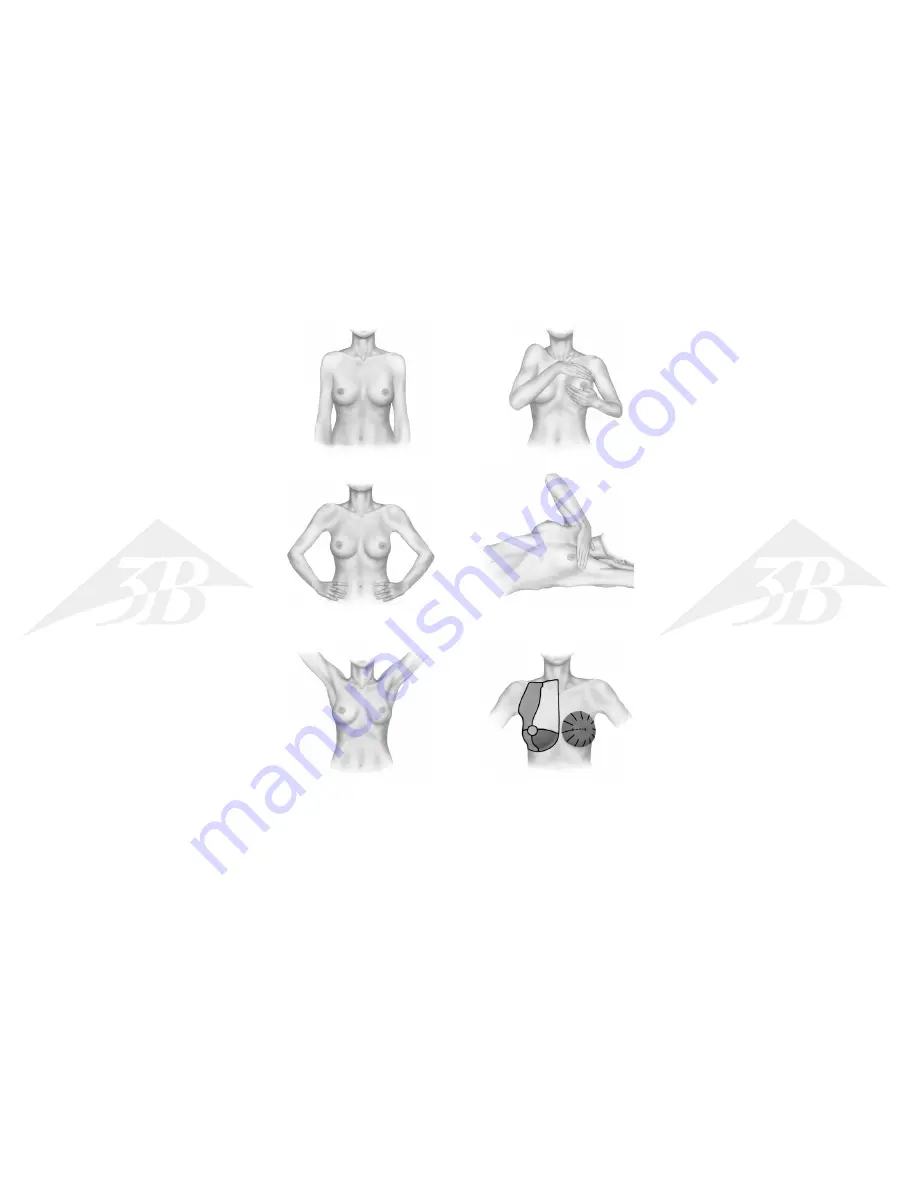
®
®
How to begin
Step in front of a large mirror with the upper body unclothed and
relax. Direct your attention to your breast with your arms relaxed
at your sides. Slowly turn in both directions to examine your chest
from a diagonal perspective and from the side. Also bend down.
Is there anything unusual? Upon taking a closer look you might
find differences in shape, size or position of both breasts: they are
usually not exactly symmetrical. In the course of the monthly exami-
nations you should become so familiar with the look of your
breasts that you will immediately notice any changes and anoma-
lies.
What to look for
Now place your hands on your hips and look at yourself from the
front again and then turn to both sides. Are there changes in com-
parison to the previous month regarding shape and position of
your breasts? Have their size or look changed? Compare both
sides! Are there any retractions or protrusions of the skin? Watch
out for any redness or discoloration. Are there any fine skin protu-
berances ("orange skin”)? Do not forget the area of the fold
below your breast. If you notice any of the described or other
changes which persist throughout the menstrual cycle please con-
sult your gynecologist.
Examination
Slowly lift up your arms several times and clasp your hands behind
the neck: Do both breasts follow the upward movements of your
arms in a regular way or does one of the breasts not follow these
movements as usual? Can the breast tissue be easily shifted
against the chest wall? Please check for any changes of your nip-
ples and their areolae: has any redness or inversion occurred
recently? Are both nipples approximately at the same height?
Carefully check that no liquid can be squeezed out of the nipple.
Palpation in Upright Position
Begin with the self-examination of your breast while you are stan-
ding. You can also examine your breast in the shower or after
applying oil to the skin. You can practice your examination skills!
With your pointer, middle and ring fingers of one hand together,
place the fingertips flatly onto the skin of the breast on the other
side. First perform palpation of the tissue with slight, then increa-
English
Self Examination of the Female Breast
sing pressure against the chest wall or the palm of your other
hand. In this way you can feel the layers both at the surface and at
greater depth. Also repeat the examination while lifting up the
elbow, placing the hand in the neck.
Also check the armpits for lumps or hardness, first while the arm is
hanging down loosely, then while lifting it up. By the way, disor-
ders which do not concern the breast can also cause swelling of
the lymph nodes in the armpit. Consult your doctor on any new
lumps, especially if they cause no pain.
Palpation in Reclined Position
For a thorough examination lie down in a comfortable position on
your back, with the head flat down. To examine your left breast,
lift up the left arm and place the hand behind the neck. If you have
rather large breasts, turn to the right side (perhaps with drawn up
legs) so that the left breast settles evenly on the chest wall. Now
carefully examine the left breast and the indicated adjacent areas
with the fingertips of the right hand. Then proceed with the other
side. Systematically examine the marked area around the breast
including the pit above the collarbone for lumps or changes. In the
area between the armpit and the breast there are frequently
benign changes of the tissue. However, since carcinomas are most
likely to occur in this region, it is especially important: Show any
recent changes to your gynecologist.
Systematic Procedure
A thorough examination of your breast should include the entire
marked region: from the breastbone as middle line towards the
sides to include the armpits, from the armpits down to below the
fold of the breast and up to the pit above the collarbone. Develop
a system that won’t miss any of these regions and that you follow
in each self-examination. You can proceed in any of the following
ways:
• Star-shaped, proceeding from the edges of the breast region
towards the middle. Then examine the area behind the nipple.
• Proceeding in parallel lines, moving upwards and downwards.
• Proceeding in a spiral form, starting with the outer regions and
moving towards the center of the breast.
For orientation purposes when you wish to perform a thorough
examination or re-examination of a specific region you can imagi-
ne that the breast is divided into quadrants or wedges as in a
clock dial, adding the distance to the breast nipple.
Dr. med. Sven Ehart
Self Examination of the Female Breast
English
Содержание L50
Страница 1: ...L50 L51 L55 L50 L51 L55 ...
Страница 12: ...5 3 8 7 2 1 4 6 5 3 7 4 6 1 2 ...
Страница 13: ......
Страница 14: ...L50 L51 L55 01 01 3 3B Scientific Products www 3bscientific com ...
































